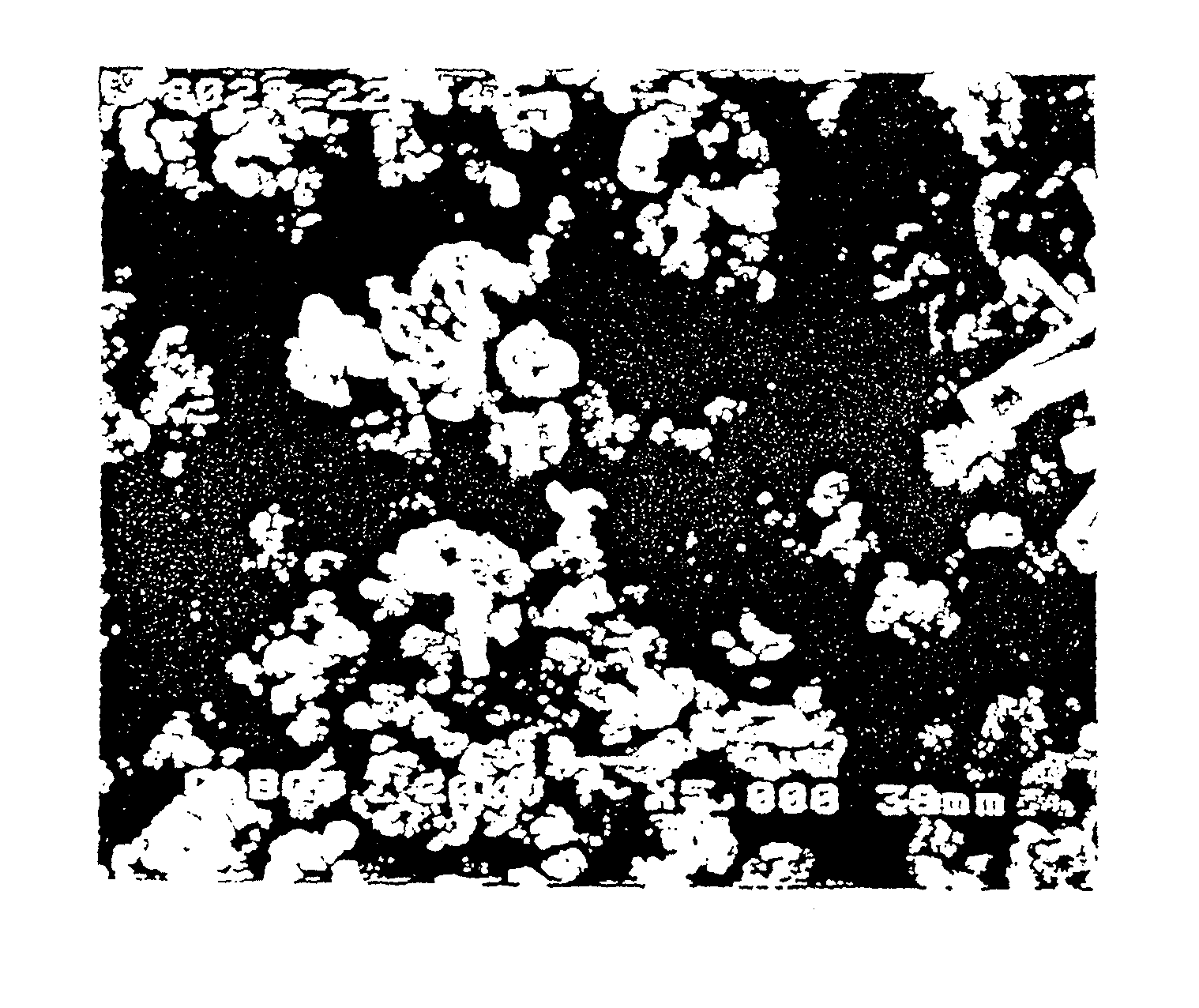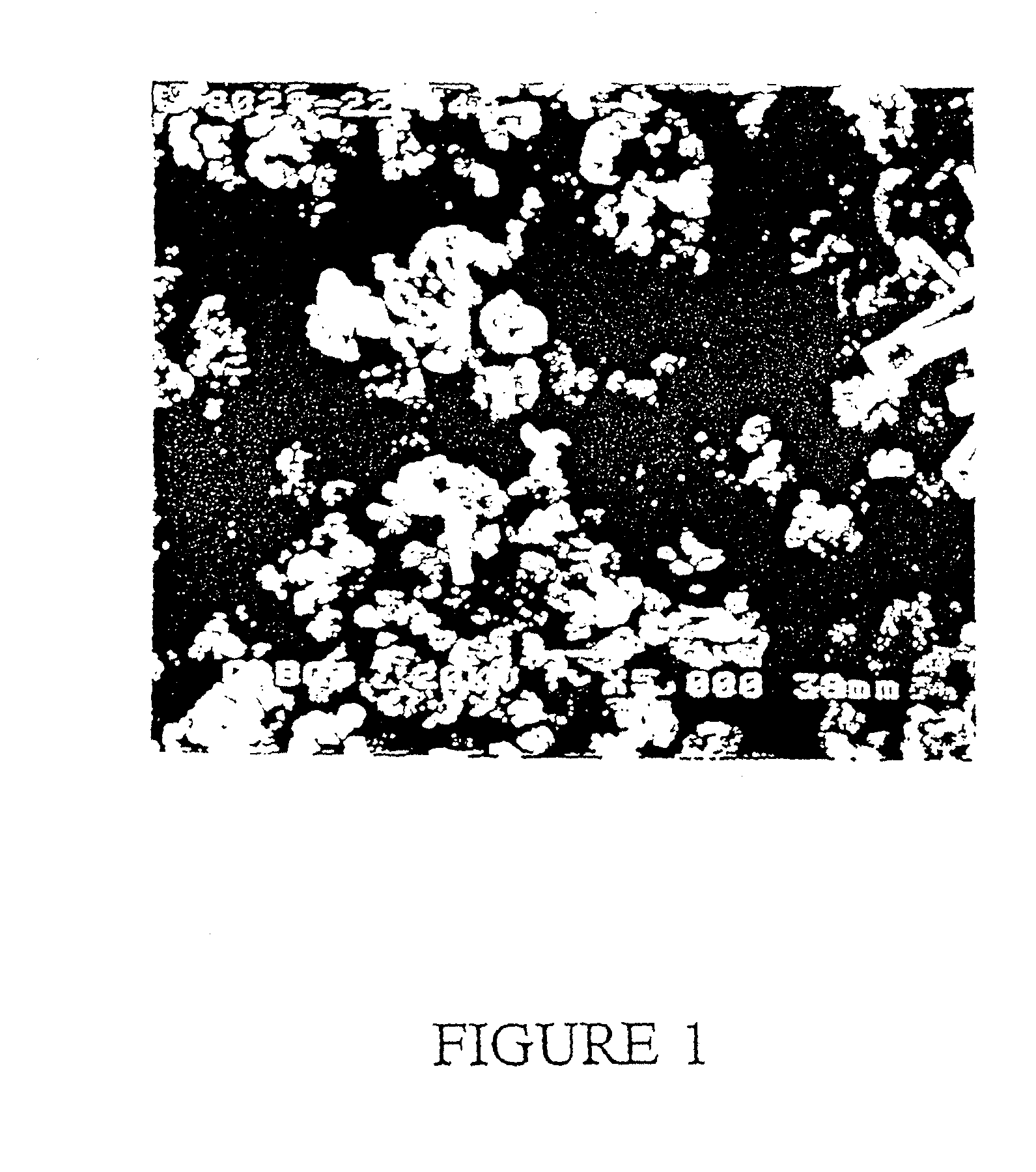Methods of making a niobium metal oxide
a technology of niobium metal oxide and niobium, which is applied in the field of making niobium metal oxide, can solve the problems of complicated manufacturing process, increased manufacturing cost, and inability to complete substitute niobium for tantalum, and achieve the effect of improving crush strength
- Summary
- Abstract
- Description
- Claims
- Application Information
AI Technical Summary
Benefits of technology
Problems solved by technology
Method used
Image
Examples
example 1
[0071] +10 mesh Ta hydride chips (99.2 gms) with approximately 50 ppm oxygen were mixed with 22 grams of Nb.sub.2O.sub.5 and placed into Ta trays. The trays were placed into a vacuum heat treatment furnace and heated to 1000.degree. C. H.sub.2 gas was admitted to the furnace to a pressure of +3 psi. The temperature was further ramped to 1240.degree. C. and held for 30 minutes. The temperature was lowered to 1050.degree. C. for 6 minutes until all H.sub.2 was swept from the furnace. While still holding 1050.degree. C., the argon gas was evacuated from the furnace until a pressure of 5.times.10.sup.-4 torr was achieved. At this point 700 mm of argon was readmitted to the chamber and the furnace cooled to 60.degree. C.
[0072] The material was passivated with several cyclic exposures to progressively higher partial pressures of oxygen prior to removal from the furnace as follows: The furnace was backfilled with argon to 700 mm followed by filling to one atmosphere with air. After 4 minut...
example 2
[0073] Samples 1 through 20 are examples following similar steps as above with powdered Nb.sub.2O.sub.5 as indicated in the Table. For most of the examples, mesh sizes of the starting input material are set forth in the Table, for example 60 / 100, means smaller than 60 mesh, but larger than 100 mesh. Similarly, the screen size of some of the Ta getter is given as 14 / 40. The getters marked as "Ta hydride chip" are +40 mesh with no upper limit on particle size.
[0074] Sample 18 used Nb as the getter material (commercially available N200 flaked Nb powder from CPM). The getter material for sample 18 was fine grained Nb powder which was not separated from the final product. X-ray diffraction showed that some of the getter material remained as Nb, but most was converted to NbO.sub.1.1 and NbO by the process as was the starting niobium oxide material Nb.sub.2O.sub.5.
[0075] Sample 15 was a pellet of Nb.sub.2O.sub.5, pressed to near solid density, and reacted with H.sub.2 in close proximity to...
example 3
[0077] This experiment was conducted to show the ability of the niobium oxides of the present invention to form at high formation voltages and yet retain an acceptable DC leakage. The niobium oxide of the present invention was compared to a capacitor formed from commercially available tantalum and niobium metal. In particular, Table 2 sets forth the basic characteristics of the materials that were used to form the capacitor for this example. The C606 tantalum is a commercially available product from Cabot Corporation. The niobium oxide used in Example 3 was prepared in manner similar to Example 1. Table 3 further set forth the chemical compositions of components other than the niobium metal for the niobium oxide of the present invention and the niobium metal which was used for comparison purposes. Tables 4-7 set forth the data obtained for each formation voltage starting at 15 volts and ending at 75 volts. The data is also plotted in FIG. 12. The particular capacitor anodes which we...
PUM
| Property | Measurement | Unit |
|---|---|---|
| Time | aaaaa | aaaaa |
| Time | aaaaa | aaaaa |
| Time | aaaaa | aaaaa |
Abstract
Description
Claims
Application Information
 Login to View More
Login to View More - R&D
- Intellectual Property
- Life Sciences
- Materials
- Tech Scout
- Unparalleled Data Quality
- Higher Quality Content
- 60% Fewer Hallucinations
Browse by: Latest US Patents, China's latest patents, Technical Efficacy Thesaurus, Application Domain, Technology Topic, Popular Technical Reports.
© 2025 PatSnap. All rights reserved.Legal|Privacy policy|Modern Slavery Act Transparency Statement|Sitemap|About US| Contact US: help@patsnap.com



